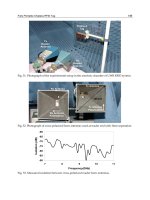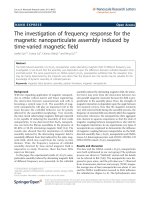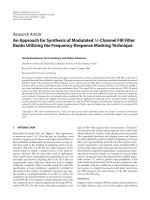9 grid frequency response
Bạn đang xem bản rút gọn của tài liệu. Xem và tải ngay bản đầy đủ của tài liệu tại đây (1.81 MB, 35 trang )
Power Systems Engineering Course:
Grid Frequency Response
Jason MacDowell
© 2016 General Electric International, Inc. All rights reserved. Not for distribution without permission.
CAISO Frequency Response Study
Adopted from CA Stakeholder Conference
December 13, 2011
GE Energy
Nicholas W. Miller
Miaolei Shao
Sundar Venkataraman
For PSEC 2016: This study helped establish some
important fundamentals. The industry is moving
fast on this topic. Updates and new notes added
since the original work are in GREEN
CAISO
Clyde Loutan
Mark Rothleder
2
© 2016 General Electric International, Inc. All rights reserved. Not for distribution without permission.
Frequency Response: Basics
•
Grid must maintain balance between load and generation
•
Large disturbances, particularly trips of large generating plants,
cause unbalance that must be corrected by “Frequency Response”
•
Frequency response covers multiple time frames
• inertial response (up to a few seconds)
• governor response (aka “Primary Response” – 1s to 10s of seconds)
• AGC response (re-dispatch) (aka “Secondary Response” - tens of
seconds to tens of minutes)
•
•
Committed synchronous generation naturally contributes to
system inertia.
• inertial response for these resources is not controllable, and
is not a function of loading level
Some synchronous generation provides governor response, if
(a) governors are enabled and
(b) it has “headroom” to increase output
© 2016 General Electric International, Inc. All rights reserved. Not for distribution without permission.
Frequency Response: Today’s Reality
• System governor response (primary response) has been declining
steadily in some parts of the US for many years: Subject of Sept 23,
2010 FERC Technical Conference and NERC Comments of October
14, 2010
Now subject to new (approved on January 14,
2014) NERC Standard BAL-003-1 which establishes
“Frequency Response Obligation”
• This predates the rapid recent growth of wind generation in North
America
• Declining response results in deeper frequency (nadir) excursions for
system disturbances, increasing the risk of under-frequency load
shedding (UFLS) and cascading outages
• Concern is most acute at lighter load conditions
•
economics favor fewer generators committed with less
governor response
•
worst disturbances are not dependent on system load level
• The issue is getting considerable attention in many circles
© 2016 General Electric International, Inc. All rights reserved. Not for distribution without permission.
A Example from WECC
• 2010 WECC database
• Light summer load (110GW: 65-75% peak)
• Full dynamic modeling
• data used today to make planning decisions
• Disturbance: 3 x Palo Verde NPS (loss of 4132 MW)
• really big event
• not design basis, but has happened
The authors gratefully
acknowledge the support of the
Western Electricity Coordinating
Council (WECC) Renewable
Energy Modeling Task Force
(REMTF), and its chairman,
Abraham Ellis, in supplying
access to planning data for this
work
© 2016 General Electric International, Inc. All rights reserved. Not for distribution without permission.
Inertia vs. Governor
Response
• Combination of inertia &
governor response dictates
minimum frequency (Fmin) (Nadir)
• Governor response dominates
later (DF), until AGC takes over
(not modeled here)
Total Generation
Inertial Response
~1400 MW/0.1 Hz
(~ 0.9 % of peak load)
Nominal Frequency Response
(NERC guideline is >1%)
Governor (Primary)
GovernorResponse
Response
110,000
Load Response
105,000
100,000
0
5
10
15
20
25
30
35
40
Time (seconds)
60.1
Frequency of Various WECC Buses
60
• At 40 seconds:
Frequency at
Malin 500kV Bus
59.9
Frequency (Hz)
~3800 MW Governor Response
~270 mHz Frequency Deviation
Total Load
115,000
Power (MW)
• Inertial response dominates
initial frequency decline
120,000
DF
59.8
59.7
59.6
Fmin (Nadir)
59.5
59.4
0
5
10
15
20
25
Time (seconds)
© 2016 General Electric International, Inc. All rights reserved. Not for distribution without permission.
30
35
40
Frequency Response with Wind:
What’s Different?
Commitment and dispatch
• Wind generation causes some synchronous generators to be decommitted, and some to be dispatched down to lower power levels
Inertia
• Modern variable speed wind turbine-generators do not naturally
contribute to system inertia
• De-commitment of some generators reduces system inertia
Governor Response
• Wind generation, like many generation resources, including nuclear,
boiler follow steam, etc., does not contribute to governor response
without incurring significant operational cost penalties
• Other resources that have governor response may be
• De-committed, removing their contribution
• Dispatched down, giving more “headroom”
© 2016 General Electric International, Inc. All rights reserved. Not for distribution without permission.
Outline
• Study Objectives
• Development of Study Database and Performance Metrics
• Frequency Response of Base Cases
• Frequency Response of High Renewable Penetration Cases
• Factors Affecting Frequency Response
• Mitigation Measures
• Conclusions
8
Study Objectives
• Frequency response to large generation outages for CAISO as well
as the overall WECC, under a variety of system conditions
• Impact of unit commitment/dispatch on frequency response
• Impact of generator output level on governor response
• Potential mitigation measures
© 2016 General Electric International, Inc. All rights reserved. Not for distribution without permission.
9
Outline
• Study Objectives
• Development of Study Database and Performance Metrics
• Frequency Response of Base Cases
• Frequency Response of High Renewable Penetration Cases
• Factors Affecting Frequency Response
• Mitigation Measures
• Conclusions
10
Study Base Case
This presentation focuses on
this case (~18% Penetration)
© 2016 General Electric International, Inc. All rights reserved. Not for distribution without permission.
11
Frequency Performance Metrics
20 to 52 sec
•
Frequency Nadir (Cf)
•
Frequency Nadir
Time (Ct)
•
LBNL Nadir-Based
Frequency Response
(MW Loss/Δfc*0.1)
•
GE-CAISO NadirBased Frequency
Response (Δ MW/Δfc
*0.1)
•
Settling Frequency
(Bf)
•
NERC Frequency
Response (MW
Loss/Δfb*0.1)*
•
GE-CAISO SettlingBased Frequency
Response
(Δ MW/Δfb*0.1)
•
NERC BAL-003-1 finalized since this study: sample for “B” is average
over
window
from Inc.
20 All
to rights
52 sec
afterNot
the
starts
© 2016 General
Electric
International,
reserved.
forevent
distribution
without permission.
12
Key to Case Summary Metrics
The ratio between governor response (GR) and other
conventional units
GR-Governor Response; BL-Base Load; NG-No Governor
© 2016 General Electric International, Inc. All rights reserved. Not for distribution without permission.
13
Outline
• Study Objectives
• Development of Study Database and Performance Metrics
• Frequency Response of Base Cases
• Frequency Response of High Renewable Penetration Cases
• Factors Affecting Frequency Response
• Mitigation Measures
• Conclusions
14
Frequency and Governor Response to Loss of Two Palo
Verde Units
Weekend Morning – High CAISO Wind
and Solar Case
California is Contributing
© 2016 General Electric International, Inc. All rights reserved. Not for distribution without permission.
15
Performance Matrix for Loss of Two Palo Verde Units
•
Kt high outside of
CA, so behavior was
good
•
650MW/0.1Hz
response target for
WECC
•
CA is roughly 1/3
the size of WECC
(31.5% of
650MW/0.1Hz is
205MW)
•
CA contributed less
than 1/3 because
rest of system did
better due to higher
kt
Since this study, industry increasingly focused on
“fast frequency response”…very important!
Weekend Morning – High CAISO Wind and Solar Case
Overall response and
contribution depends
on how neighbors
behave
© 2016 General Electric International, Inc.
287 MW/0.1Hz is comfortably
above the proposed target of
All rights
reserved.
Not for distribution without permission.
205
MW/0.1Hz
16
Governor Response Discussion - Timing of Governor
Response
Winter Low Load – High CAISO Wind Base Case
Speed Matters!
© 2016 General Electric International, Inc. All rights reserved. Not for distribution without permission.
17
Governor Response Discussion - Governor Withdrawal
with Load Control Response
Winter Low Load – High CAISO Wind Base Case
18 governor response units, with
total generation of 5338 MW,
have turbine load controller
model (lcfb1) model
200 MW of governor response is
deliberately withdrawn, representing
almost 10 percent of total frequency
response
Load Control should be frequency dependent
© 2016 General Electric International, Inc. All rights reserved. Not for distribution without permission.
18
Outline
• Study Objectives
• Development of Study Database and Performance Metrics
• Frequency Response of Base Cases
• Frequency Response of Higher Renewable Penetration Cases
• Factors Affecting Frequency Response
• Mitigation Measures
• Conclusions
19
Generation Summary for Weekend Morning – High
WECC Wind and Solar Case
WECC
# of Units
38590
678
51587
12997
37384
431
9603
453
21762
6810
GR Pgen (MW)
GR MWCAP (MW)
GR Headroom (MW)
BL Pgen (MW)
NG Pgen (MW)
Wind Pgen (MW)
Solar Pgen (MW)
MW Capability
CU Pgen (MW) (GR + BL + NG)
Total Pgen (MW)
Total Load (MW)
Wind Pgen/Total Pgen
Solar Pgen/Total Pgen
Kt
GR Pgen/CU Pgen
GR Pgen/Total Pgen
GR Headroom/CU Pgen
GR Headroom/Total Pgen
11%
© 2016 General Electric International, Inc.
CA
# of Units
5514
127
9785
4271
9478
155
1757
121
8646
6667
127146
85577
114775
110798
36333
1562 16749
30525
35155
19.0%
5.9%
40.6%
45.1%
33.6%
15.2%
11.3%
28.3%
21.8%
26.9%
43.4% 32.9%
18.1%
25.5%
14.0%
403
4%
31.5%
Non-CA
# of Units
33075
551
41802
8727
27906
276
7845
332
12428
144
90125
68826
84250
75643
14.8%
0.2%
46.4%
48.1%
39.3%
12.7%
10.4%
1159
47.5%
Kt is smaller for nonCA here
(more
realistic)
All rights reserved. Not for distribution
without
permission.
20
Comparison of Impact of Increasing Levels of Wind on
Frequency Performance to Loss of Two Palo Verde Units
More wind has worse but
acceptable frequency
response.
California’s frequency
response improves (from
287 to 311 MW/0.1 Hz –
well above the 205
MW/0.1Hz target) .
The fractional contribution
in California increases
greatly, from 20% to 27%.
The behavior of resources
outside of California has
impact on the California
response.
© 2016 General Electric International, Inc. All rights reserved. Not for distribution without permission.
21
Outline
• Study Objectives
• Development of Study Database and Performance Metrics
• Frequency Response of Base Cases
• Frequency Response of High Renewable Penetration Cases
• Factors Affecting Frequency Response
• Mitigation Measures
• Conclusions
22
Factors Degrading Frequency Response – Fewer
Governors in Operation
Keep all other factors impacting frequency response fixed:
Governor Response (GR) units
• 25 GR units, with total dispatch of 3144 MW and rating (MWCAP) of 5189 MW for a
total of 2045 MW headroom, were selected to dispatch up 2045 MW and then were set
as base load.
• Another 11 GR units, with total dispatch of 3034MW and rating (MWCAP) of 4165 MW
were selected to dispatch down 2045 MW.
Reduce the count of generators providing response by 25, while holding headroom fixed
(i.e. Kt is reduced).
Headroom not sufficient alone – Kt matters!!!
© 2016 General Electric International, Inc. All rights reserved. Not for distribution without permission.
23
Factors Degrading Frequency Response – Reduced
Headroom
• Small Change in Headroom
• Practical Minimum Headroom
• Extreme minimum Headroom
© 2016 General Electric International, Inc. All rights reserved. Not for distribution without permission.
24
Reduce Headroom - Practical Minimum Headroom
GR Pgen (MW)
GR MWCAP (MW)
GR Headroom (MW)
BL Pgen (MW)
NG Pgen (MW)
Wind Pgen (MW)
Solar Pgen (MW)
MW Capability
CU Pgen (MW) (GR + BL + NG)
Total Pgen (MW)
Total Load (MW)
Wind Pgen/Total Pgen
Solar Pgen/Total Pgen
Kt
GR Pgen/CU Pgen
GR Pgen/Total Pgen
GR Headroom/CU Pgen
GR Headroom/Total Pgen
13640
WECC
CA
Non-CA
# of Units
# of Units
# of Units
18942
284 5045
92 13897
192
27057
8169
18888
3974
9765
8115
3124
4991
44815
510 12780
168 32035
342
9678
320 2617
99
7060
221
18094
8411
9684
2550
2550
0
102194
73435
94392
91300
34527
1114 20442
29683
26190
19.2%
2.7%
26.5%
25.8%
20.1%
11.1%
8.6%
28.3%
8.6%
23.7%
25.5% 24.7%
17.0%
15.3%
10.5%
359
25.6%
67667
52992
64710
65111
15.0%
0.0%
27.9%
26.2%
21.5%
9.4%
7.7%
Condition in this case was considered to be challenging
© 2016
Electric
International,
Inc. All infrequently.
rights reserved. Not for distribution without permission.
andGeneral
might
occur
relatively
755
25.4%
25









